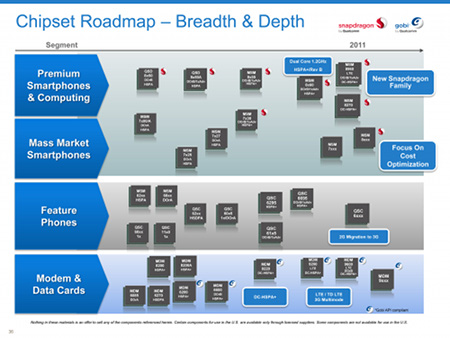Qualcomm spins a Snapdragon for video-savvy tablets
Feb 10, 2011 — by LinuxDevices Staff — from the LinuxDevices Archive — 1 viewsQualcomm announced a new entry in its ARM-based “Snapdragon” family of processors, this time targeting tablet devices as well as smartphones. The APQ8060 includes dual cores clocked at 1.2GHz, a homegrown “Adreno 220” GPU, and the ability to capture stereoscopic HD video or 3D still images.
 Some chipmakers overwhelm with data sheets, block diagrams, and other minutiae about their new processors. Not Qualcomm. However, yesterday's high-profile launch of the WebOS-powered HP TouchPad tablet PC (right) inspired a press release providing a few tidbits of information about the dual-core, ARM-based CPU that's inside.
Some chipmakers overwhelm with data sheets, block diagrams, and other minutiae about their new processors. Not Qualcomm. However, yesterday's high-profile launch of the WebOS-powered HP TouchPad tablet PC (right) inspired a press release providing a few tidbits of information about the dual-core, ARM-based CPU that's inside.
Qualcomm says the processor being employed is the previously unknown APQ8060, featuring dual cores. (They're both clocked at 1.2GHz, according to HP, though the chipmaker didn't reiterate that detail.)
Touting the APQ8060 as "the ultimate solution for the latest multitasking smartphones and tablets," Qualcomm described the processor as part of its 8×60 series. This is the third generation of the company's Snapdragon family of processors (see later in this story for background).
Many ARM licensees base their chips' GPUs (graphics processing units) on intellectual property obtained from third parties such as Imagination Technologies. But for the APQ8060, Qualcomm devised its own GPU, according to Brent Sammons, a graphics product manager for the company: "We created the solution from the ground up, so power efficiency is optimized," he says in a video on a Qualcomm blog.
According to Qualcomm, the APQ8060's integrated Adreno 220 GPU has "twice the processing power of its predecessor." The device supports cameras up to 16 megapixels, and can capture stereoscopic still images up to eight megapixels or stereoscopic HD video, the company adds.
Qualcomm provided no additional technical details, but said APQ8060-based devices will be able to provide 3D output via HDMI. They'll also offer 30fps 1080p video capture and playback, Adobe Flash 10 web browsing, and "console-quality" gaming, the company added.
HP's TouchPad will provide Adobe Flash, but otherwise doesn't appear to tap the APQ8060's video talents very deeply: There's only a front-facing 1.3 megapixel camera, and no HDMI output is cited.
Qualcomm's 80×0 family …
As we've already suggested, Qualcomm doesn't provide much public detail about its processors. However, the APQ8060 is apparently a derivative of the MSM8960 Qualcomm showed off last year.

Qualcomm's MSM8960
(Click to enlarge)
In a November presentation for financial analysts, Qualcomm Executive Vice President Steve Mollenkopf said MSM8960 would be the company's first mobile processor to move to a 28nm design. A new microarchitecture will allow the device to deliver approximately five times the performance of the original Snapdragon chip while using 75 percent less power, he added.
Another slide (below) revealed that the MSM8960 would include dual cores clocked at 1.2GHz, much like the MSM8260 and MSM8660 that were announced in June. Where the MSM8260 targets only HSPA+ networks and the MSM8660 supports both HSPA+ and CDMA2000 1xEV-DO Rev. B, however, the MSM8960 will support both of these plus LTE, making it the "world's first multi-mode 3G/4G integrated chipset," Qualcomm added.

Qualcomm's MSM and QSD roadmap
(Click to enlarge)
In an apparent comparison to the original Snapdragon, Mollenkopf said the MSM8960 will offer "four times" the graphics performance. He added that the GPU would, like those on the MSM8260 and MSM8660, provide OpenGL-ES and OpenCL v1.1 compatibility as well as 1080p video encode/decode.
… and more about the Snapdragons
The original 1GHz QSD8250/8650 Snapdragon chipsets debuted in Nov. 2007, featuring a Scorpion core that — like the ARM Cortex-A8 — is based on the ARMv7 instruction set and offers similar superscalar technology. (In fact, many observers refer to it flatly as a member of the Cortex-A8 family.)
The QSD8x50 was followed in 2009 by a 1.3GHz QSD8650A, which added 2D/3D graphics accelerators, and was touted for its up to 30 percent lower power consumption. Qualcomm later announced a 1GHz, mid-range MSM7x30 variant of the Snapdragon design said to be capable of capable of playing 720p video.
In its June announcement, Qualcomm called the MSM8x60 chipsets the first dual-core versions of the Snapdragon. In 2009, however, the company began sampling a somewhat similar QSD8672 that combined two 45nm-fabricated 1.5GHz Scorpion cores.
The QSD8672 and MSM8x60 were both touted by Qualcomm as representing the third generation of Snapdragon technology. With its 28nm fabrication, the MSM8960 (and APQ8060, we presume) moves ahead still further.
Raj Talluri, vice president of product management for Qualcomm, stated, "Our work with industry leaders has allowed us to showcase the full spectrum of Snapdragon's graphics and multimedia capabilities in both the tablet and smartphone space. With more than 75 Snapdragon devices already announced, 150 Snapdragon devices in development, and over 100 high end mobile games optimized for our GPU, Qualcomm continues to be a leader."
This article was originally published on LinuxDevices.com and has been donated to the open source community by QuinStreet Inc. Please visit LinuxToday.com for up-to-date news and articles about Linux and open source.